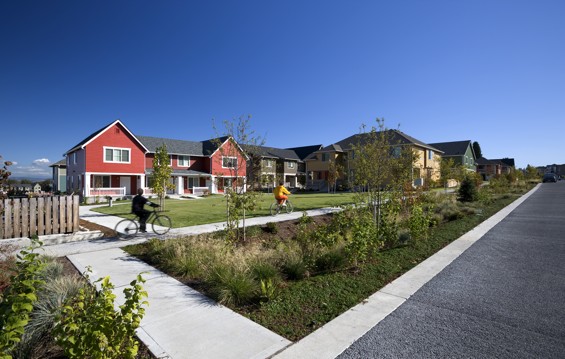Why Build Green

Green building makes affordable housing a true asset to the community, one that gives low-income residents more comfortable and high-performance homes, respects the environment, and strengthens the regional economy.
Policies that encourage or require green building practices, especially for publicly funded affordable housing, are a wise investment in a sustainable future. The payoff is not just on residents' utility bills and owners' maintenance costs. Indoor air quality improvements translate into fewer trips to the emergency room, trees and landscaping prevent stormwater from overflowing the sewers, and construction site recycling creates a valuable materials market and new jobs for the low and highly skilled workers.
Developers and builders benefit, too. They gain valuable experience with leading building techniques and with a team approach that improves design and construction. The proof is already out there: a wide range of projects across the country have met green standards within the cost of conventional building methods. In fact, green building can even lower construction costs and help gain neighborhood support for an affordable housing project.
Economics
Investments in green affordable housing benefit the regional economy by meeting the need for truly low-cost homes. The costs of adopting new methods and materials quickly fall away, giving rise to better buildings with lower maintenance, operations, and insurance costs, and even more consistent rent or mortgage payments. Energy efficiency not only reduces residents' bills, but also keeps utility rates lower for all customers by reducing demand and limiting the need for new power plants and transmission lines.
Green building can also create job opportunities and career ladders for low-income residents. Policies that help local businesses grow with the green building market and training programs for "green collar" jobs are the foundation of a strong economic development strategy.
Environment
Green building offers us tremendous opportunities to save energy, cut greenhouse gas emissions, conserve natural resources, improve air and water quality, and reduce waste. If all buildings in the U.S. met leading green building standards, national energy use and global warming emissions would drop by at least ten percent. The potential for reducing waste is even greater, with the rate of construction waste recycling at over 70 percent. Green building is also critical when it comes to managing stormwater runoff, a priority in the Washington, D.C. metropolitan area. By making every development site work like a forest: absorbing water, nurturing trees that clean our air and cool our city, and giving kids a place to safely play and explore the natural world, we will all benefit.
Community
Green building emphasizes a cooperative approach that brings developers, government officials, and community members together from day one. Encourage plans that enhance parks and playgrounds and that create safe, well-lit walking routes to transit and businesses where neighbors can socialize and exercise regularly. We should strive to create neighborhoods where residents look out for one another and care for the parks, trees, and streams where their children play.
Why do it now?
Green building offers us the chance to benefit everyone: residents, owners, neighbors, local governments, regional businesses, and the local and global environment. The right policies can make these opportunities and benefits a reality even when presented with the budget limitations of an affordable housing project. The average additional cost of building green is approximately two percent higher than that of traditional building and is falling. Many tools are in place to support these market changes, and new policies, financial instruments, and regulations are starting to make building green a mainstream practice in affordable housing. The time to build green is now.
Links
Regional Legislation and Incentive Programs:
DC Green Building Act of 2006 (PDF)
The 2006 Green Communities Criteria, the standard for affordable housing in the DC Green Building Act.
Montgomery County, Maryland Green Building law (PDF) and property tax credit legislation (PDF)
Arlington, Virginia green building incentive programs: Density Bonus and Green Home Choice
Benefits of Green Building:
Emerald Cities: The Promise of Green Development, The American Prospect Magazine
Greening Affordable Housing (PDF) Environmental Building News, March 2005
This reprint of this article is posted by permission of the publisher, BuildingGreen, Inc.
Affordable Housing Goes Green (PDF) Apartment Professional, April 2005
Green building facts and figures from The Playbook for Green Buildings + Neighborhoods
In this Section:
Economic sense
Green affordable housing costs less than conventional residential development over the long run and can even reduce construction costs. Green, high performance techniques, systems, and materials will deliver more...
Environmental Sense
Energy efficiency Buildings account for 35 percent of U.S. energy use and over 60 percent of electricity demand. Green homes consistently use a third less energy, making energy efficiency...
Community sense
Green building gives affordable housing residents safe, comfortable, and healthy homes. Work with builders and neighbors to put community development and residents at the center of a building's design....

